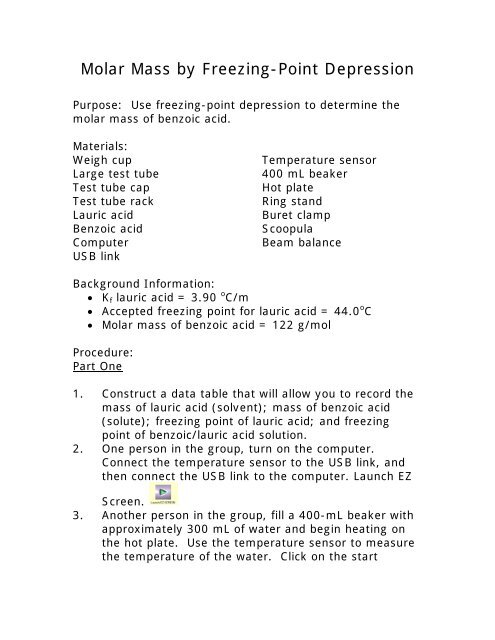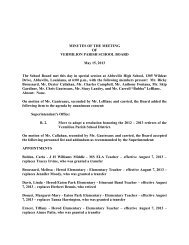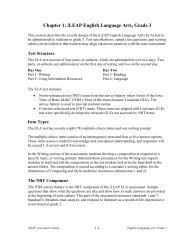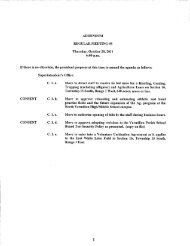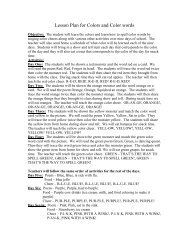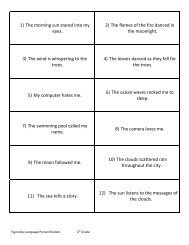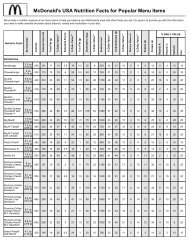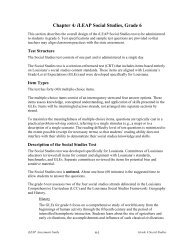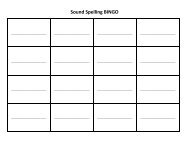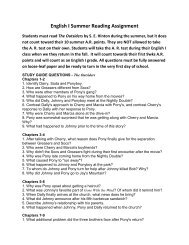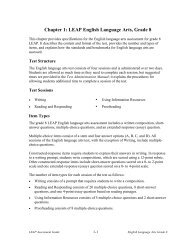Molar Mass by Freezing-Point Depression
Molar Mass by Freezing-Point Depression
Molar Mass by Freezing-Point Depression
You also want an ePaper? Increase the reach of your titles
YUMPU automatically turns print PDFs into web optimized ePapers that Google loves.
<strong>Molar</strong> <strong>Mass</strong> <strong>by</strong> <strong>Freezing</strong>-<strong>Point</strong> <strong>Depression</strong><br />
Purpose: Use freezing-point depression to determine the<br />
molar mass of benzoic acid.<br />
Materials:<br />
Weigh cup<br />
Large test tube<br />
Test tube cap<br />
Test tube rack<br />
Lauric acid<br />
Benzoic acid<br />
Computer<br />
USB link<br />
Temperature sensor<br />
400 mL beaker<br />
Hot plate<br />
Ring stand<br />
Buret clamp<br />
Scoopula<br />
Beam balance<br />
Background Information:<br />
• K f lauric acid = 3.90 o C/m<br />
• Accepted freezing point for lauric acid = 44.0 o C<br />
• <strong>Molar</strong> mass of benzoic acid = 122 g/mol<br />
Procedure:<br />
Part One<br />
1. Construct a data table that will allow you to record the<br />
mass of lauric acid (solvent); mass of benzoic acid<br />
(solute); freezing point of lauric acid; and freezing<br />
point of benzoic/lauric acid solution.<br />
2. One person in the group, turn on the computer.<br />
Connect the temperature sensor to the USB link, and<br />
then connect the USB link to the computer. Launch EZ<br />
Screen.<br />
3. Another person in the group, fill a 400-mL beaker with<br />
approximately 300 mL of water and begin heating on<br />
the hot plate. Use the temperature sensor to measure<br />
the temperature of the water. Click on the start
utton. You want your water to reach<br />
approximately 90 o C. Do not let the water boil at any<br />
time.<br />
4. While waiting for the water to warm, mass 8 grams of<br />
lauric acid, record the mass, and transfer the acid to<br />
the test tube.<br />
5. Clamp the test tube to the ring stand with a buret<br />
clamp. Lower the clamp/tube assembly until the test<br />
tube is in the water, but not touching the bottom of the<br />
beaker.<br />
6. Heat the lauric acid in the water bath until it melts.<br />
7. Move the clamp/tube assembly out of the water.<br />
8. Place the temperature sensor in the liquid lauric acid.<br />
Stir gently with the temperature sensor until the<br />
temperature reaches 60 o C.<br />
9. When the temperature reaches 60 o C, exit out of EZ<br />
Screen and launch Data Studio <strong>by</strong> double clicking on<br />
the icon in the bottom right tray. Then click on<br />
.<br />
10. Click on the start button. Continue collecting<br />
data until the temperature reading remains constant for<br />
about 2 minutes. You should see crystals of lauric acid<br />
forming in the solution; you have reached the freezing<br />
point of the lauric acid. Click on the stop button.<br />
11. Print enough copies of the graph for everyone in the<br />
group. Exit out of the program.<br />
12. Move the buret clamp/test tube/temperature sensor<br />
back into the hot water bath and liquefy the lauric acid<br />
once again.<br />
13. Carefully remove the temperature sensor from the<br />
liquid lauric acid. Allow any liquid drops of acid to fall<br />
back into the test tube. Remove the temperature<br />
sensor and wipe it clean with a paper towel.
Part Two<br />
1. Obtain 1 gram of benzoic acid. Place the benzoic<br />
acid in the test tube that contains the lauric acid<br />
from Part One.<br />
2. Heat the benzoic acid/lauric acid mixture until it<br />
liquefies.<br />
3. Launch EZ Screen again.<br />
4. Repeat steps 6-13 from Part One for the benzoic<br />
acid/lauric acid mixture.<br />
5. Pour the liquefied solution into the waste container in<br />
the back of the room. Warning: Do not pour the<br />
liquid solution down the sink! It will solidify<br />
and clog the drain.<br />
6. Clean up your area and wash your hands.<br />
7. Go back to the classroom area and fill in your data<br />
table using your graphs.<br />
Calculations:<br />
1. Calculate the change in freezing point (ΔT f ) when the<br />
benzoic acid was added to the lauric acid.<br />
2. Calculate the molality (m) of the solution.<br />
3. Using the formula for molality, calculate the moles of<br />
benzoic acid used.<br />
4. Using the mass of benzoic acid used and the answer<br />
to #3, calculate the experimental molar mass of<br />
benzoic acid.<br />
5. Using the accepted value for the molar mass of<br />
benzoic acid, calculate your percent error.


